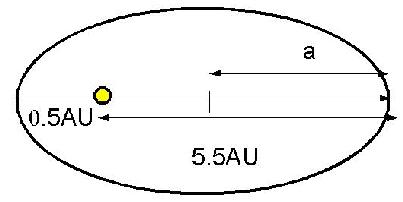(Problem 5-Chp. 2) If a space probe were sent into an orbit around the sun that brought it as close as 0.5AU to the sun an as far away as 5.5 AU, what would its orbital period be?

We
need to use Kepler's 3rd law: P^2= a^3
where the semimajor axis a is a=(0.5AU+5.5AU)/2=3.0AU
So, P^2=3 x 3 x 3= 27
Thus, P=5.2 years.
(Review 2-Chp. 6) Why do we expect planets to have differentiated?
The major reason why we expect other planets to have differentiated is because, the Earth at some point during its formation differentiated. Differentiation is a natural process that occurs when the interior of a planet is molten and the denser materials sink in. Differentiation probably took place initially due to the heat of formation of the planets in the solar nebula model. Also radiactive decay in later stages might have aided this process.
The mean densities of other terrestrial planets indicate that they are also differentiated.
(Review 8-Chp.6)Why do we believe that the lunar crater Tycho is a young crater?
The Tycho crater has bright ejecta rays extending from it. Rays fade with time as small meteor impacts break them; as well as expose to sunlight. Since the rays are quite bright, this crater must be young.
(Review 15-Chp. 6) How does the large-impact hypothesis explain the moon's lack of iron?
The large impact hypothesis tells us that the material used to form the moon comes from the collision between the Earth and a large planetesimal. The material ripped off from the Earth is mainly crust and mantle. The iron core of the planetesimal would have sink to the center of the Earth and coalesce with the Earth's original core. Thus, in this hypothesis the material that forms the moon is mostly rock and mantle and very little iron.
(Problem 5-Chp. 6) What is the ratio of the volume of the moon to the volume of the Earth? why is that different from the ratio of the masses?
density= mass/volume so, volume=mass/density
moon's mass= 7.35 x 10^22 Kg= 7.35 x 10^25 g
moon's volume= (7.35 x 10^25 g) / (3.36 g/cubic cm) = 2.19 x 10^25 cubic cm
earth's mass=5.976 x 10^24 Kg= 5.976 x 10^27 g
earth's volume=(5.976 x 10^27 g) / (5.497 g/cubic cm) = 1.087 x 10^27 cubic cm
ratio= moon's volume / earth's volume
= (2.19 x 10^25 cubic cm) / (1.087 x 10^27 cubic cm)= 0.02
The ratio of the masses is actually smaller (0.01) because the density of the moon is only 3.36 g/cubic cm and that of the Earth is 5.5 g/cubic cm.